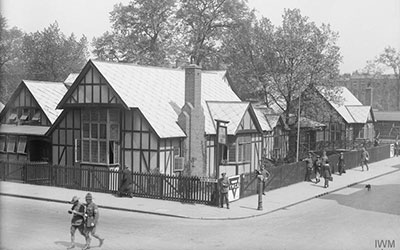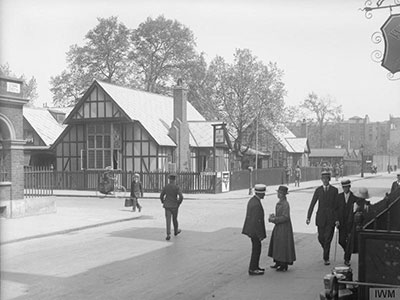A library enquiry recently sparked an intriguing trip to the archive, revealing a very different image of Bloomsbury to that of today.
The Institute of Historical Research Library team recently received an enquiry regarding the history of the Institute and in particular the varied buildings which the IHR has occupied during its history. As a result, following some research in the Institute’s archive, we have been researching the history of Bloomsbury, in particular Malet Street and Gower Street due to their proximity to the site that the IHR occupies today.
Interest in this project was further spiked following the discovery of photographs held by the Imperial War Museum in London documenting the area during the First World War. The photographs clearly highlight the greatly changed surroundings from 1918 to the present day.
The photographs show the corner of Store Street and Gower Street at the intersection where the London School of Hygiene and Tropical Medicine is housed now. Also shown is a Y.M.C.A building that was used as accommodation for troops during the First World War. The area looks almost unrecognisable from today with significantly less traffic!
The Institute of Historical Research was first housed in similar accommodation to that pictured in the photographs above, with the Institute only moving to a newly built Senate House when ‘Senate House lost its veil of scaffolding and University staff moved in’ during 1937. (Simpson, The University of London’s Senate House:Charles Holden, Classicism & Modernity, University of London, 2005, p37) Prior to this, the IHR building was frequently referred to as ‘the army huts’ because of its external resemblance to those provided for troops. The building was a single-storey structure and rested on the basements and cellars of houses that had been cleared before the war. Additionally, it should also be noted that at this time Malet Street was significantly narrower than it is presently, only being widened in the 1930s.
The secretary and librarian of the IHR from 1946-1971 recalled how the streets of Malet Street and Gower Street were made up of single-storey buildings. Mr A. Taylor-Milne remarked that, ‘In the academic year 1924-5 some of us undergraduates at University College used to walk down Malet Street to the headquarters of the University of London Union, temporarily housed at the corner of Montague Place, in what had been a large Y.M.C.A hut for the troops during the First World War. On the way we passed the first home of the Institute of Historical Research, a neat row of single-storied structures.’ (Birch and Horn, The History Laboratory: The Institute of Historical Research 1921-96, University of London, 1996, p 24).

YMCA London Shakespeare Hut, 1914-1918, Archive of the National Council of YMCA’s, Record No: YMCA/K/1/12/75 © Cadbury Research Library: Special Collections, The University of Birmingham
The archives of the Y.M.C.A, housed within the collections of the University of Birmingham, contain many striking examples recording the cottage-style buildings that were located right along Malet Street. An example of these ‘huts’ is that of the ‘Shakespeare Hut’, a Y.M.C.A recreation hut built for the rest and recuperation of serving forces during the First World War with a remit to entertain the troops with dramatic performances of Shakespeare productions. The building was situated on the corner of Malet Street and Keppel Street, the site now occupied by the London School of Hygiene and Tropical Medicine.
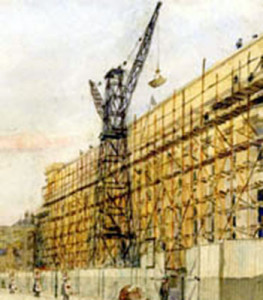
British Museum, ‘King Edward VII galleries under construction’, graphite and watercolour, 1910, (detail) ©BM
The history of the British Museum site occupying Montague Place also sheds light on the history of Bloomsbury, with the scope of the site mostly unchanged from its conception to the present. The north entrance (situated on Montague Place and facing Senate House today) was opened in 1914. Interestingly, however, the north entrance was never intended to be a public entrance. Instead the entrance and galleries on this side of the building were originally meant to face a long avenue which would be part of a victory parade route. The saluting gallery, a reminder of this grand scheme, can still be seen above the north entrance.
Following the end of the First World War, building work commenced across the Bloomsbury area. The IHR’s Secretary and Librarian from 1927-1943 recalled watching the works begin along Malet Street. He commented that, ‘the southern end of the Institute’s building faced to the west another vacant site, soon to be covered by the London School of Hygiene and Tropical Medicine. I watched its building from my office next to the Institute’s entrance and used to say that the names Frank, Pettenkofer and Briggs would be found graven on my heart!’ (Birch and Horn, p 40)
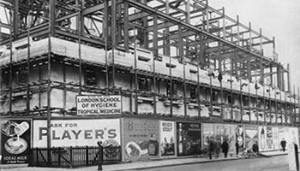
London School of Hygiene and Tropical Medicine, Construction of the Keppel Street Building, c.1927 © LSHTM Archives
Similarly, in 1921 further along Malet Street, a new theatre was built by the Royal Academy of Dramatic Art [RADA]. This building occupied land which backed onto the Academy’s existing buildings on Gower Street.
It is clear therefore, that the area underwent enormous transformation during this time. Indeed, the vast urban development projects that were taking place within the area can be evidenced through London County Council’s legislative directive to widen both Malet Street and Montague Place in 1928 (London County Council (General Powers) Act 1928 sections 48-53 (50.9) in Simpson, p19).
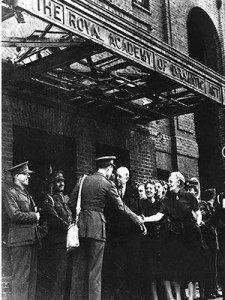
Royal Academy of Dramatic Art, Vanbrugh Theatre Entrance, Malet Street © RADA
In many of the images Bloomsbury is unrecognisable in relation to its present-day form. The archival photographs in this way allow for a window onto an often forgotten past. However, whilst the architecture may have changed, the institutions lining Malet Street have remained and the work and research carried out within them provides a continuum to the present day.
This short introduction is only intended as an overview of the visual history of the area. However, several archives contain significant holdings on the changing architectural face of Bloomsbury and each respective institution’s history. Therefore, for more information please see:
– There is a small online exhibition created to mark the IHR’s ninetieth anniversary. See also a previous IHR blog post on ‘The IHR’s Original Home‘.
– LSHTM’s project ‘Resurrecting the Shakespeare Hut‘ will commemorate the 100th anniversary of the opening of the YMCA Shakespeare Hut on the School’s Keppel Street site on 11th August 1916. The project, made possible by a joint-award from the Heritage Lottery Fund, will include an audio-visual exhibition, performances and local First World War oral history testimonies.

